Contents
A brightly saturated range of spectacular leaves of a perennial herbaceous plant – geyhera – can decorate any flower garden or mixborder. It gives extraordinary lightness and delicacy to flower bed compositions, for which it is appreciated by landscape designers. Hybrid geyhera Caramel retains its beauty throughout the growing season and looks great in group plantings, in landscape compositions of amazing beauty.
Description of Heuchera Caramel
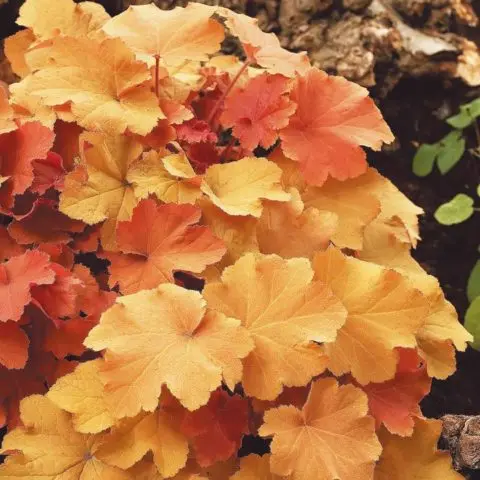
Heuchera variety Caramel is a short, about 20 – 30 cm tall, dome-shaped bush, completely strewn with large, attractive leaves of a golden-copper shade. Appearing in the spring, the basal leaves of the culture have a reddish tint, but gradually, by summer, they brighten and become intensely golden on top, and dull carmine on the inside. At the same time, they are pubescent, and by autumn they gradually change color to a more intense one. Geyhera blooms in June-July with small, pale pink flowers, which are collected in paniculate inflorescences and are located on long, erect peduncles. However, it is valued not so much for its modest flowering, but for the decorativeness of the bush, abundantly covered with caramel, brightly colored leaves.
The new, hybrid variety of geyhera Mega Caramel impresses with its large dimensions. It reaches a height of 50 cm, the leaves are twice the size of standard ones, as well as giant peduncles with numerous bell flowers.
Geichera Caramel in landscape design
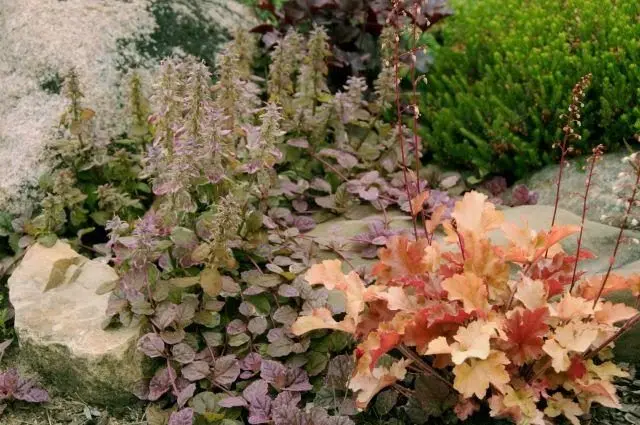
Among the plants widely used in landscape design, geyhera occupies a leading position. Specifically, the Caramel and Mega Caramel varieties are used as decorations:
- flower beds and mixborders;
- rock gardens, rockeries;
- edges of paths, terraces, alleys;
- coastal strips of reservoirs;
- borders;
- garden plots;
- city flower beds.
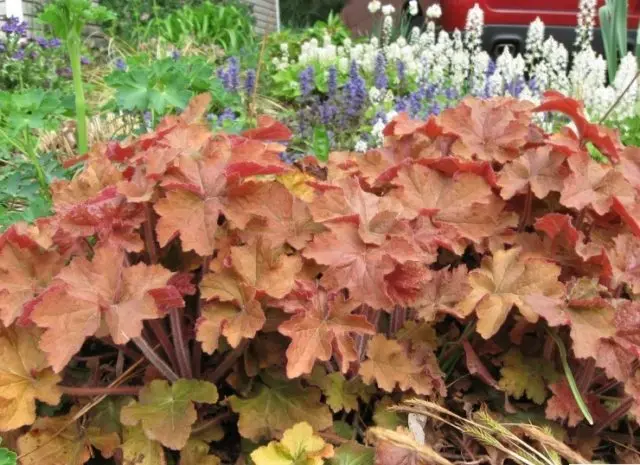
Heuchera Caramel will be a bright accent in any combined planting from a group of plants of the same or different species. Heuchera looks incredibly harmonious with ornamental cereals, bergenia, geraniums and will effectively shade the near-trunk circles of tall trees and shrubs.
Caramel goes well with early-flowering bulbous crops, as it begins to delight early with its exquisite leaf rosette. Excellent neighbors for culture will be daylilies, irises, hostas and roses. Due to its unpretentiousness, the perennial is planted with Caramel geyher and in city flower beds. You can also use it for cutting.
Growing hybrid Heuchera Caramel from seeds
It will not be difficult to grow a hybrid of geyhera Caramel and a hybrid of Mega Caramel from seeds. For this:
- Loose soil is taken from a mixture of soddy soil, humus and river sand in equal quantities and filled with a container.
- Small seeds do not need to be buried: it is enough to carefully place them on the substrate and sprinkle with a small amount of wet sand.
- The container is covered with a film and kept until germination at a temperature not lower than 22 – 3 degrees Celsius.
- Periodically, the ground is moistened with water and the planting is ventilated.
- Shoots appear after 15 – 20 days, so the film is immediately removed.
- With the development of 2 true leaves, seedlings dive into separate containers. If weather conditions allow, they can be immediately planted in open ground.
Landing is carried out from the end of May to the beginning of June. Flowering varieties of geyhera Caramel and Mega Caramel, grown from seeds, as shown in the photo and in the description, will begin in the 3rd year after planting.

Planting and caring for Geykhera Caramel in the open field
The main features of Caramel geyhera are unpretentiousness, good winter hardiness and ease of care. It comes from rocky shores, so it does not tolerate waterlogging, stagnant moisture. To eliminate the risk of root rot, gardeners sprinkle the rhizome with a mixture of fine expanded clay or coarse sand and soil before planting. In its homeland, geyhera Caramel is adapted to grow on poor soils, so overfeeding with fertilizers can adversely affect development. Therefore, it is easy to conclude that three main factors can provoke root rot in a plant:
- excessive moisture;
- acidic soil;
- large doses of organic matter.
An obligatory agrotechnical technique is the hilling of bushes before winter, as plants protruding rosettes can freeze.
Site preparation
Heuchera Caramel is a heat-loving plant that prefers sunny places. However, the midday active rays of the sun can harm her. Therefore, the landing site should be sunny, but shaded at noon, so that the bushes do not burn out under the scorching rays. Variety Caramel actively develops on neutral soils. Therefore, an acidic environment before planting geyhera should be fertilized with chalk, lime or wood ash.
Rules of landing
The basic rules for planting geyhera Caramel are similar for all varieties of this decorative flower crop. Among them:
- organization of deep drainage;
- the presence of fertile, light, cultivated soil, with a layer of at least 20 cm of soil;
- carrying out hilling once a year;
- mulching in the first year of life for the winter with sawdust;
- annual spring deepening of the roots, which tend to become bare during the winter;
- removal of old, withered leaves.
Heuchera Caramel is planted in fertile soil in small planting pits with a drainage layer of pebbles, river sand. The earth must be warm, so the landing is timed to the end of April or the beginning of May, depending on the region and weather conditions. In group planting, the distance between geyhers is maintained at 25 – 30 cm.
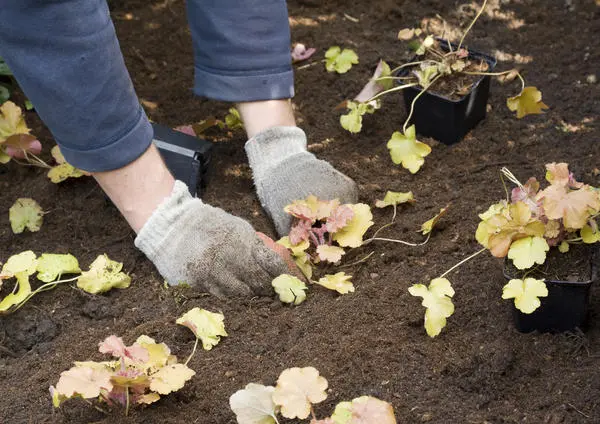
Watering and top dressing
Undemanding to conditions, geykher of a grade Caramel and Mega Caramel does not demand introduction of additional moisture. Even during a drought, watering is carried out no more than once a week. If the summer is rainy, then there is no need to water the geyher, as its root system can quickly rot. However, regular watering should be regular and moderate, but without waterlogging the land and waterlogging it. They bring water directly under the root, making sure that it does not get on the leaves, which can cause them to burn in the summer heat.
Fertilizing with mineral fertilizers is carried out 3 times per season – in early spring, in summer and before the onset of cold weather. If initially the soil was well fertilized, then caramel geyhera does not need fertilizers. From the soil of geyher Caramel is able to take all the substances necessary for active growth. Especially do not overfeed with organic compounds.
Trimming
Pruning Heuchera Caramel is to remove old, withered leaves in the spring. If necessary, the procedure is carried out in the fall. After each removal of the leaves, the soil around the bush is mulched with peat mixed with humus.
Preparation for winter
Heuchera Caramel must be prepared for winter rest. To do this, hilling is carried out and subsequent mulching from a mixture of river sand, peat and tree bark. The plant is able to easily survive winters with temperatures up to 20 degrees below zero, which are typical for the middle, central strip. However, in the conditions of Siberia, the geyher of the Caramel variety needs shelter. To do this, you can use spruce branches, cardboard or a special covering material. Young seedlings must be hidden for the winter under the spruce branches. In spring, the near-ground part of the soil near the plant is cleared of fallen leaves.
You can additionally familiarize yourself with the rules of agricultural technology in the video:
Reproduction
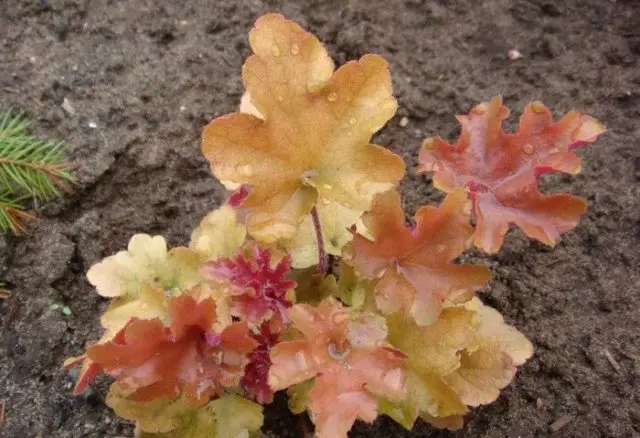
Heuchera is propagated in one of the standard ways:
- seeds;
- cuttings;
- division of the bush.
About growing from seeds has already been said above. For cuttings from geyhera Caramel, which is at least 3 years old, one-year-old rosettes are taken. Harvesting of cuttings is carried out in early spring – in March, and planting – at the end of spring. The optimal time for planting under a film shelter is the end of May – the beginning of June. After the formation of a strong root system, the plants are planted in a permanent place.
The propagation method by dividing the bush is suitable for Caramel geyhera, not less than 3 years old and not more than 4 years old. Suitable dates are May or August. To do this, the bush is abundantly shed several hours before planting. Carefully dig out and with a sharp knife divide the rhizome into several parts. Delenki are immediately planted in a permanent place.
Pests and diseases
Geichera variety Caramel is resistant to diseases and pests. However, with improper care, the culture is threatened by:
- damage by snails or slugs – if the plant is in a shaded place;
- spotting or downy mildew;
- rotting of the root system.
Chemical preparations such as Intavir, reducing watering and transplanting geyhera to a more lit place will help get rid of pests. Special tools are also used to combat downy mildew, spotting, which are characterized by the appearance of spots on the leaves. Excess moisture and regular fertilizing with organic fertilizers leads to rotting of the roots. In this case, the plant is dug up, all rotten, diseased root shoots are removed and transplanted into fresh soil with the addition of sand and peat.
Conclusion
Geichera Caramel and its hybrid form Mega Caramel are easy to grow and care for, which has long been noticed by landscape designers and amateur gardeners. Compliance with all agricultural practices will allow you to enjoy the fabulous decorative effect of a spectacular beauty every year, able to completely transform the garden look with your original outfits.









